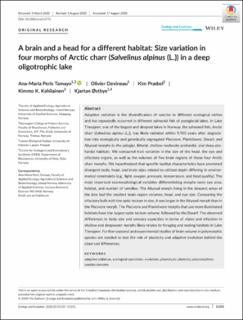| dc.description.abstract | Adaptive radiation is the diversification of species to different ecological niches and has repeatedly occurred in different salmonid fish of postglacial lakes. In Lake Tinnsjøen, one of the largest and deepest lakes in Norway, the salmonid fish, Arctic charr (Salvelinus alpinus (L.)), has likely radiated within 9,700 years after deglaciation into ecologically and genetically segregated Piscivore, Planktivore, Dwarf, and Abyssal morphs in the pelagial, littoral, shallow-moderate profundal, and deep-profundal habitats. We compared trait variation in the size of the head, the eye and olfactory organs, as well as the volumes of five brain regions of these four Arctic charr morphs. We hypothesised that specific habitat characteristics have promoted divergent body, head, and brain sizes related to utilized depth differing in environmental constraints (e.g., light, oxygen, pressure, temperature, and food quality). The most important ecomorphological variables differentiating morphs were eye area, habitat, and number of lamellae. The Abyssal morph living in the deepest areas of the lake had the smallest brain region volumes, head, and eye size. Comparing the olfactory bulb with the optic tectum in size, it was larger in the Abyssal morph than in the Piscivore morph. The Piscivore and Planktivore morphs that use more illuminated habitats have the largest optic tectum volume, followed by the Dwarf. The observed differences in body size and sensory capacities in terms of vision and olfaction in shallow and deepwater morphs likely relates to foraging and mating habitats in Lake Tinnsjøen. Further seasonal and experimental studies of brain volume in polymorphic species are needed to test the role of plasticity and adaptive evolution behind the observed differences. | en_US |

